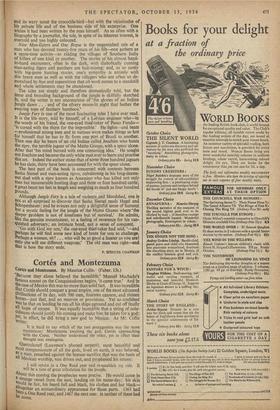Murderous Beasts
Crocodile Fever. By Lawrence Earl. (Collins. 12s. 6d.) Nine Man-Eaters and One Rogue. By Kenneth Anderson. (George Allen & Unwin. 15s.) Jungle Fury. By Sasha Siemel. (Hutchinson. 15s.) THE days of hunting big-game in order to collect ungainly and often hideous trophies have virtually gone—and not only because the ancestral manor house is no longer there to accommodate them. Nowadays your big-game hunter arms himself with a camera or— as is the case with all three books we are concerned with here—. he indulges his thirst for adventure and justifies his lust for killing, by ridding the world of murderous beasts—crocodiles, rogue elephants, and man-eating tigers. and its wary scout the crocodile-bird—but with the vicissitudes of his private life and of the business side of his enterprise. One Wishes it had been written by the man himself. As so often with a biography by a journalist, the tale, in spite of its inherent interest, is overtold and too highly coloured. Nine Man-Eaters and One Rogue is the ungarnished tale of a man who has devoted twenty-five years of his life—one gathers as a spare-time activity—to ridding the villages of Southern India of killers of one kind or another. The stories of his almost hand- to-hand encounters, often in the dark, with diabolically cunning man-eating tigers and panthers are hair-raising; and, as so rarely with big-game hunting stories, one's sympathy is entirely with this brave man as well as with the villagers who are often so de- Moralised by fear and superstition that all work comes to a standstill and whole settlements may be abandoned.
The tales are simply and therefore dramatically told, but the tense and brooding background of the jungle is skilfully sketched in, and the writer is not unconscious of 'the glories of an Indian jungle dawn . . . and of the silvery moon-lit night that bathes the swaying tops of feathery bamboos.'
Jungle Fury is one of the most fascinating tales I have ever read. It is the life story, told by himself, of a Latvian engineer who—in the words of his friend, the one-eyed thief-taker of Passo Fundo-
' is cursed with the thirst for the impossible.' He fights—and beats
— professional strong men and in various ways makes things so hot for himself that he has to fiy from one part of Brazil to another. Then one day he hears of an old Indian called Joachim who hunts the tigre, the terrible jaguar of the Matto Grasso, with a spear alone. After that 'his mind burned with one consuming idea.' He sought out Joachim and became the only white man ever to learn and practise this art. Indeed the author states that of some three hundred jaguars he has slain, thirty have been accounted for with the spear alone. The best part of the book is concerned with contests between Sasha Siemel and man-eating tigres, culminating in his long-drawn7 out duel with a tigre known as Assassino who has killed not only Men but innumerable hunting dogs and three or four hundred cattle; a great beast ten feet in length and weighing as much as four hundred pounds.
Although Jungle Fury is a tale of violence and bloodshed, one is not at all surprised to discover that Sasha Siemel reads Hegel and Schopenhauer; and he evinces not only a delightful sense of humour but a mystic feeling for the jungle of the Matto Grasso where 'the deeper problem is not of loneliness but of survival.' He admits, like the genuine mountaineer, to a feeling of reverence for his van- quished adversary; an intimate bond, not a sense of conquest. `Go with God my son,' the one-eyed thief-taker had said, `—and perhaps he will find some new kind of brute for you to challenge. verhaps a woman, eh? .. . who will be as good a hunter as you are! only she will use different weapons.' The old man was right—and that is how the story ends.
F. SPENCER CHAPMAN



































 Previous page
Previous page